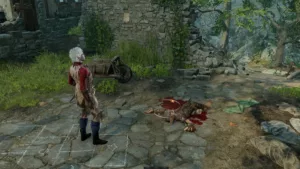At the end of a fall, a creature takes 1d6 bludgeoning damage for every 10 feet it fell, to a maximum of 20d6. The creature lands prone, unless it avoids taking damage from the fall.
Player’s Handbook, page 183
Fall Damage 5e
Fall damage is a simple mechanic in DnD 5e, which comes with advantages and disadvantages.
On the plus side, it’s very easy for DMs to run and players to remember the rules. But this simplicity also creates such unrealistic scenarios that it sometimes breaks player immersion.
We’ll go over:
-
How to calculate fall damage in 5e
-
Answers to common rules questions around how fall damage works
-
All the ways to reduce or prevent fall damage
-
Popular house rules for DMs who don’t like the 5e’s base fall damage rules
-
Optional rules for falling objects
How Much Damage Do you Take From Falling in 5e?
You take 1d6 bludgeoning damage per 10 feet you fall in DnD 5e. If you fall any less than 10 feet, you don’t take any fall damage. The maximum fall damage a creature can take is 20d6 bludgeoning damage if they fall from a height of 200 feet or greater.
Here’s the average fall damage you’ll take based on the height of your fall:
| Height of Fall | Average Bludgeoning Damage |
|---|---|
| 10 feet | 3 |
| 50 feet | 17.5 |
| 100 feet | 35 |
| 150 feet | 52.5 |
| 200 feet | 70 |
| 5,000 feet | 70 |
You can resist fall damage if you have resistance to bludgeoning damage, which will halve the damage you take from a fall. There are also other ways to avoid fall damage via class features and spells.
Fall Damage Rules 5e
The rules for fall damage in 5e are as follows:
-
Immunity to bludgeoning damage from attacks or weapons doesn’t grant immunity to fall damage. This was specifically confirmed on Sage Advice and in the Sage Advice Compendium (pg. 21).
The point here is that fall damage is not a weapon, nor is it an attack.
-
Resistance to bludgeoning damage reduces fall damage. If a feature or creature stat block gives resistance to bludgeoning damage in general, rather than bludgeoning damage from weapons/attacks, then it does apply to to fall damage.
This has been confirmed in separate Sage Advice and Twitter threads from Mike Mearls and Jeremy Crawford. The important distinction here is that something like a Barbarian’s Rage gives resistance to all bludgeoning damage, not just bludgeoning damage from weapons and/or attacks.
-
Falling doesn’t use your movement. While jumping does use your movement, allowing for gravity to take you (i.e., falling) does not use your character’s movement for the turn.
-
Falling is instantaneous, or 500 feet per round with Xanathar’s rules. The game’s basic rules assume that falling is instantaneous, but Xanathar’s Guide to Everything added an optional rule: you fall 500 feet instantly, but if you’re still falling on your next turn, you descend 500 feet at the end of that turn (XGtE 77).
This allows players to take actions while they’re falling, if they’re falling from <500 feet. Otherwise, a player cannot take actions while they are falling, unless it is in specific reaction to the act of falling (e.g., Monk's Slow Fall or the Feather Fall spell).
-
Falling into water does the same amount of damage as falling onto a solid surface, rules as written. However, Jeremy Crawford (lead game developer) states that he halves fall damage when a player falls into water in this Sage Advice thread, so that’s something.
-
A flying creature can survive a fall more easily. Another falling rule that Xanathar’s introduced involves flying creatures. The logic goes that a flyer who’s knocked prone and begins falling should still have ways to slow their descent.
If you incorporate this optional rule, you subtract the flyer’s flying speed from the total fall. So if the creature has a flying speed of 60 feet and falls 100 feet, it takes damage as though it only fell 40 feet.
Additionally, this optional rule combines with the 500 feet per second rule, allowing a flying creature to “stand up” from being knocked prone if falls from a height of more than 500 feet by spending half of its flying speed (XGtE 77).
-
Falling onto a creature divides the damage between the two creatures if the stationary creature fails a DC 15 Dexterity saving throw. Both creatures are also knocked prone, unless the impacted creature is two or more sizes larger than the falling creature. However, if the creature succeeds on its saving throw, they avoid the falling creature entirely and take no damage, and do not fall prone.
For example, if a creature falls 60 feet onto another creature and that creature fails their Dexterity saving throw, you would roll 6d6 (21 average) and divide it between each of the creatures (10 bludgeoning damage each).
This optional rule comes from Tasha’s Cauldron of Everything (TCoE 170).
How to Prevent or Reduce Fall Damage in 5e
While fall damage can certainly be lethal, there are ways to avoid taking some or even all of the damage from a fall. These include:
Class Features
-
Barbarian Rage. Barbarian’s 1st-level Rage feature grants them resistance to bludgeoning damage (PHB 45), including fall damage. So if you use Rage before superhero jumping off a building, you’ll only take half damage from the fall.
-
Monk Slow Fall. Monk’s 4th-level feature Slow Fall allows them to use a reaction to reduce falling damage by 5 times your Monk level.
By reducing the damage by -20, 4th-level Monks can safely jump off of a 50-foot landing without taking damage (5d6 = 17.5 average). Each Monk level increases your “safe” fall distance by another 10 or 20 feet.
The advantage of Monk’s Slow Fall is the reaction cast time. A Barbarian won’t be able to use their Rage mid-fall, unless they’re falling greater than 500 feet.
-
Druid Beast Form. By 8th level, Druids can turn into beasts that can fly. This offers some protection against falling, both in the potential to avoid all falling damage and in the ability to reduce falling damage via Xanathar’s rules for subtracting flying speed from the total height fallen from.
Race Features
-
Flying speed. Any race with an innate flying speed is going to have an easier time avoiding the dangers of high places and fall damage in general.
Spells
-
Feather Fall. Usable in reaction to falling, this spell slows up to 5 falling creatures’ rate of descent to 60 feet per round. Affected creatures take no falling damage and land on their feet. This is a 1st-level transmutation spell available to Bards, Sorcerers, Wizards, and Artificers.
-
Fly. The Fly spell is unique in that a creature affected by it won’t take fall damage, even if its movement speed is forced to zero via the prone, restrained, unconscious, paralyzed, or petrified conditions. They’ll simply hover in place. Of course, if the Fly spell ends, so does this hover effect.
Fly is a 3rd-level spell available to Sorcerers, Warlocks, Wizards, and Artificers, and can be upcast to affect multiple targets. However, it cannot be used as a reaction to falling, so you’ll need a <500-foot drop to use this post-fall.
-
Levitate. The Levitate spell suspends a creature or object, allowing them to hover in place for up to 10 minutes. Additionally, when the spell ends, the creature floats gently to the ground. Levitate can’t be upcast to include multiple targets and can’t be used in reaction to falling.
2nd-level spell available to Sorcerers, Wizards, and Artifiers.
-
Gaseous Form. Gives one creature you touch a 10-foot fly speed and other abilities.
-
Enhance Ability: Cat’s Grace. A multi-use buff spell that can be used to grant the target the ability to take no damage from falling 20 feet or less if it isn’t incapacitated. Good for minor and/or repeated falls.
Enhance Ability is a 2nd-level spell available to Bards, Clerics, Druids, Sorcerers, Artificers, and Oath of Glory Paladins.
-
Teleportation spells. Spells like Misty Step and Dimension Door can theoretically be used to prevent taking fall damage, if you’re falling from greater than 500 feet high.
However, there’s no official ruling on whether momentum is transferred when teleporting, so some DMs might rule that you still take all/some damage from falling even if you use this method.
Magic Items
-
Potions of Flying, Winged Boots, Wings of Flying are a few official examples. DMs can also homebrew potions of Feather Fall and the like if they foresee their players entering a location with dangerous heights and no other means of protecting themselves.
Subclass Features
-
Several subclass features give some sort of flying speed or teleportation mechanic which can be used to prevent or reduce falling damage.
Common Fall Damage House Rules for 5e
Many DMs and players have issues with DnD 5e’s base rules for falling damage. While they’re beautifully simplistic, they also remove a lot of the nuance (and danger) of how falling works in real life.
On the low-height end of the spectrum, players think it’s kind of silly that an experienced and dexterous Rogue should take any damage from a 10-foot drop.
And the high-height argument is obvious: capping fall damage at 70 average (120 maximum) means that many high-leveled and correctly-built players are in no danger of dying from a fall. Even a fall from a mile high.
While it’s true that hit points are an abstraction and players suspend disbelief all the time to play a TTRPG, I understand how unsatisfying both of these issues are for a player. Heck, taking 11 damage from jumping out of a one-story window is kind of annoying when you’re a mighty adventurer.
And brushing off a sky-dive with <30 damage taken as a Monk or Barbarian is a tad immersion-breaking.
So, here are a few semi-official and house rules that DMs can incorporate to make falling feel more realistic in DnD:
Official Optional Rules
-
Massive Damage. An optional rule for when a creature takes one instance of damage for greater than half their maximum hit points (DMG 273). The creature makes a DC 15 Constitution saving throw, and suffers a random result based on a d10 roll.
There’s a:
-
10% chance the creature drops to 0 hit points
-
20% chance they fall to 0 hit points but are stable
-
20% chance they’re stunned
-
20% chance they can’t take reactions for a round
-
30% chance they can’t take reactions and suffer disadvantage on attack rolls and ability checks for a round
-
-
Lingering Injuries. Another optional rule that DMs can either roll on or simply decide based on common sense (DMG 272).
For a fall, injuries that make sense include a limp (reduced speed and chance to fall prone when dashing) or broken ribs/a different internal injury (chance to lose an action each round).
House Rules
-
Reduced fall damage into water. Most people agree that a 10-foot jump into water shouldn’t deal any damage — kids do it all the time at publically-funded pools.
An easy fix is to start fall damage into water at 30 feet, and then add 1d6 for every additional 10 feet from there (a 30-foot drop into water definitely stings for at least 1d6 damage).
There’s also the simple idea from Jeremy Crawford to just cut the damage in half when falling into water.
-
Acrobatics check to reduce/negate fall damage. Many players hate the idea that their godlike character can’t help but tweak an ankle every time they hop down from a moderate height. There are many variations of house rules to fix this issue.
Some allow for 10 or even 20-foot drops to be taken without taking any damage if a player has a high enough Acrobatics or Dexterity modifier. Some allow for an Acrobatics check to negate or reduce the fall damage up to a certain fall height. Some set a DC of the check dependent on the height of the fall.
There are many simple and elegant ideas for fixing this common complaint.
-
Scaling damage for longer falls. There are a few variations of a house rule to increase the damage for longer falls and/or removing the damage 20d6 damage cap. The aim of all these rules is the same: make falls from obviously lethal heights actually lethal.
-
Making big (non-lethal) fall damage have a chance to knock you unconscious. A simple fix that can rely on Constitution throws, ability scores, or certain damage thresholds to occur. One of the best-thought versions of these comes from Hispters and Dragons “Hard Fall” rule — highly recommend you check out their article on it (and the whole blog) for the full details!
Ultimately, you don’t have to house rule falling damage to make it work in 5e. But if players complain about it or if you yourself don’t like how it works, any of these above options (or your own great ideas!) can create a more satisfying experience.
Falling Objects in 5e
One last word on fall damage before we go. There are no official rules for how much damage falling objects do in DnD. As I see it, there are three good options supported by the rules:
-
Treat objects like creatures. If we say that objects are the same as equivalently-sized creatures, and they’d split the damage with any creature below them if the impacted creature fails their DC 15 Dexterity save. Simple and easy to run.
-
Use the collapsing roof trap as a baseline. The DMG includes this trap, which deals 4d10 bludgeoning damage on a failed DC 15 Dexterity saving throw. However, this trap is easy to spot and disable, so the damage might suggest too high a value to be balanced for all falling objects.
-
Use 3.5 rules. In the earlier edition of DND, a 101-200 pound object falling from 20 feet dealt 1d6 bludgeoning damage. Lighter objects also dealt 1d6 damage beginning at certain heights:
Object Weight Falling Distance 200-101 pounds 20 feet 100-51 pounds 30 feet 50-31 pounds 40 feet 30-11 pounds 50 feet 10-6 pounds 60 feet 5-1 pounds 70 feet So a 150-pound object falling 100 feet would deal 9d6 bludgeoning damage, and a 3-pound object would deal 4d6 from the same height.
DnD 5e Fall Damage FAQ
Fall damage DnD 5e FAQ:
-
How to calculate fall damage in 5e: Calculating fall damage in DnD 5e is determined by the distance fallen. The basic calculation for fall damage is 1d6 (3.5 average) bludgeoning damage for every 10 feet fallen, up to a maximum of 20d6 (70 average). If a character falls less than 10 feet, no damage is taken. If they fall more than 200 feet, the damage is capped at 20d6.
-
What is the maximum fall damage in 5e? The maximum fall damage in DnD 5e is 20d6 (70 average). This occurs when a character falls from a height of 200 feet or more. The damage is calculated as 1d6 bludgeoning damage per 10 feet, up to a maximum of 20d6.
-
What happens when you fall onto a creature in 5e? Falling onto a creature in DnD 5e divides the damage between the two creatures if the stationary creature fails a DC 15 Dexterity saving throw, and both creatures are knocked prone(Tasha’s Cauldron of Everything, pg. 170). However, if the stationary creature passes its saving throw, the falling creature takes all of the damage, and the stationary creature is not knocked prone.
For example, if a creature falls 40 feet onto another creature and the stationary creature fails their Dexterity save, you would roll 4d6 and divide the result between both creatures, who are also both knocked prone.
-
Can misty step stop fall damage in 5e? No, misty step can’t directly prevent fall damage in 5e. Misty step is a 2nd-level spell that allows a caster to teleport up to 30 feet to an unoccupied space they can see, but it requires a bonus action to cast, not a reaction, like feather fall. However, if you’re using the rule that you fall 500 feet per turn, and your character is falling from a greater height, then you could use misty step on your turn to possibly avoid or reduce the damage you take from falling, provided there’s a surface nearby. This doesn’t address the question of whether momentum is carried after teleportation, so it’s ultimately up to your DM how helpful misty step is for avoiding fall damage.

![Unarmed Strike 5e [DnD Rule Guide + Damage] dnd-5e-character-sheet-and-die](https://www.dndlounge.com/wp-content/uploads/2022/03/dnd-5e-character-sheet-and-die-300x157.jpg)
![Poisoned 5e [DnD Condition, Damage Type, And Poisons Guide] dungeons-and-dragons-party-vs-lich-mini](https://www.dndlounge.com/wp-content/uploads/2022/03/dungeons-and-dragons-party-vs-lich-mini-300x194.jpg)

